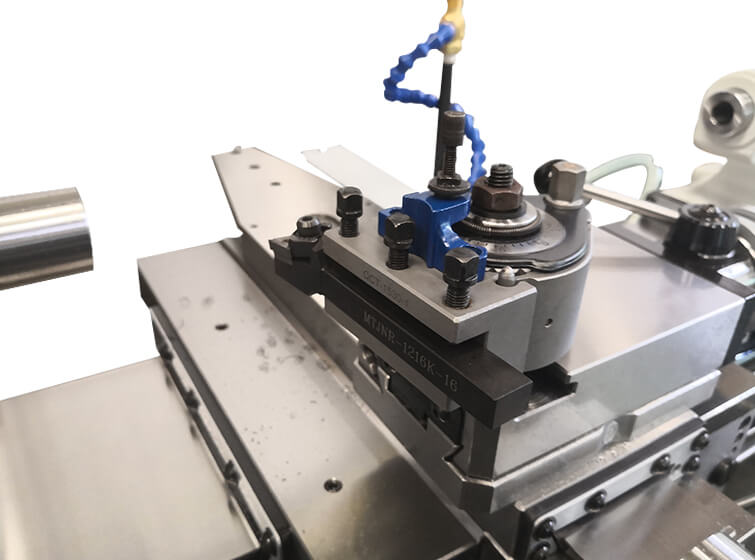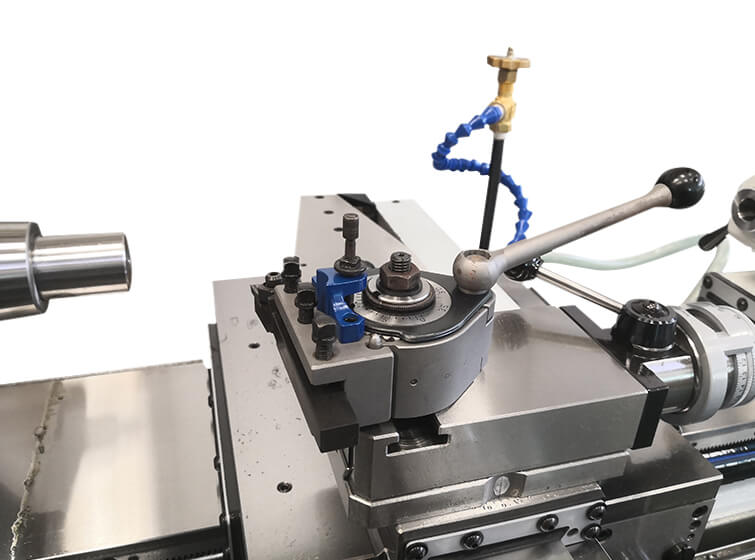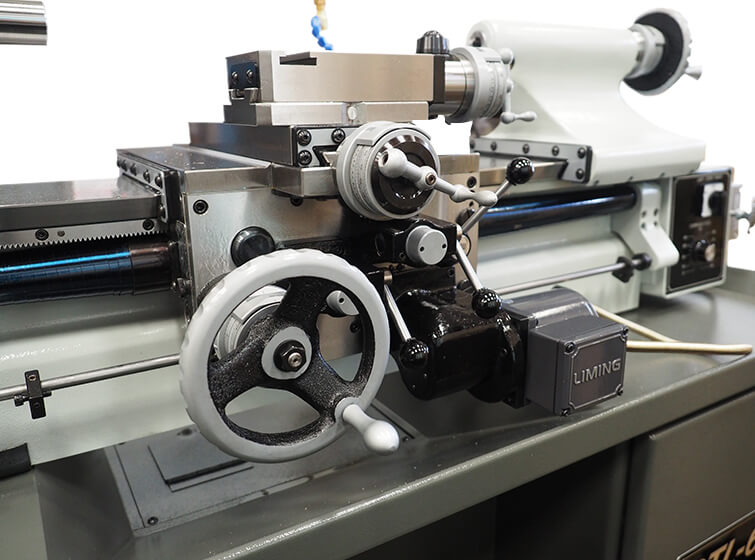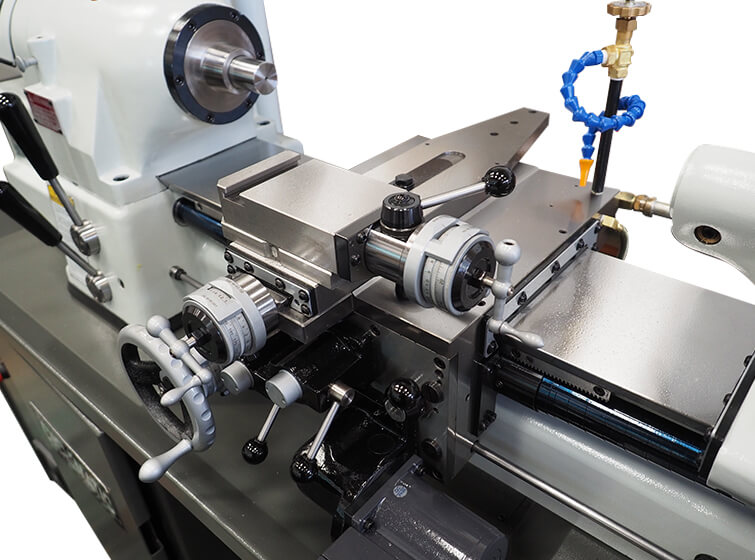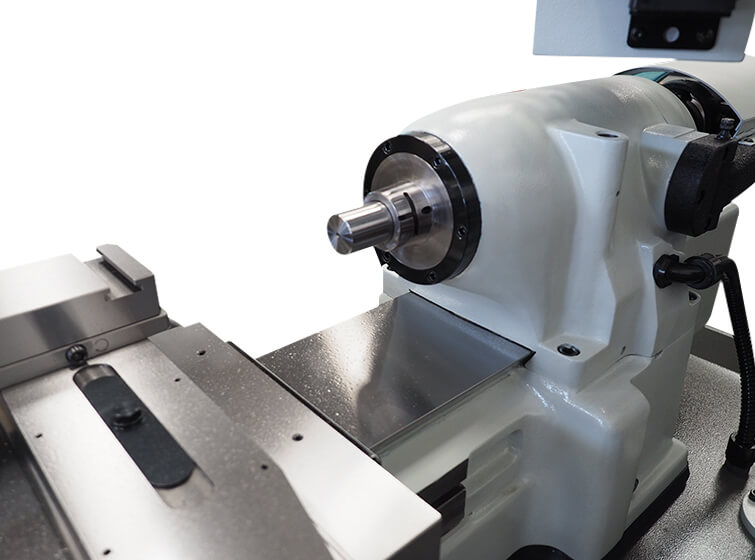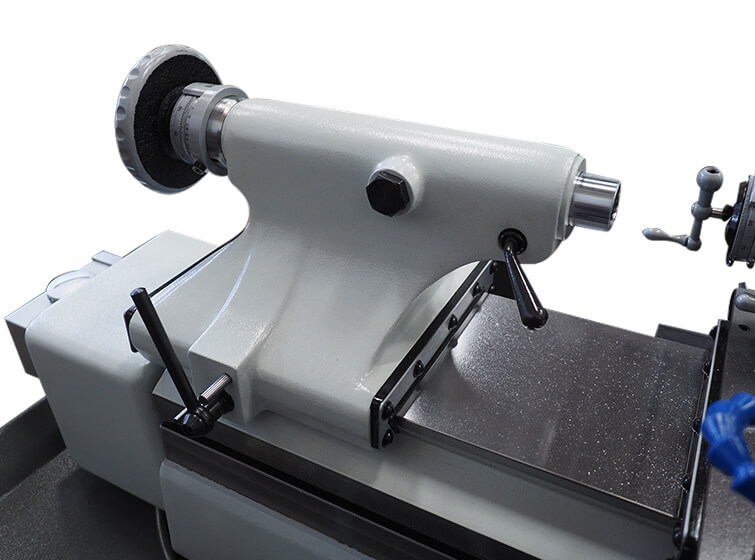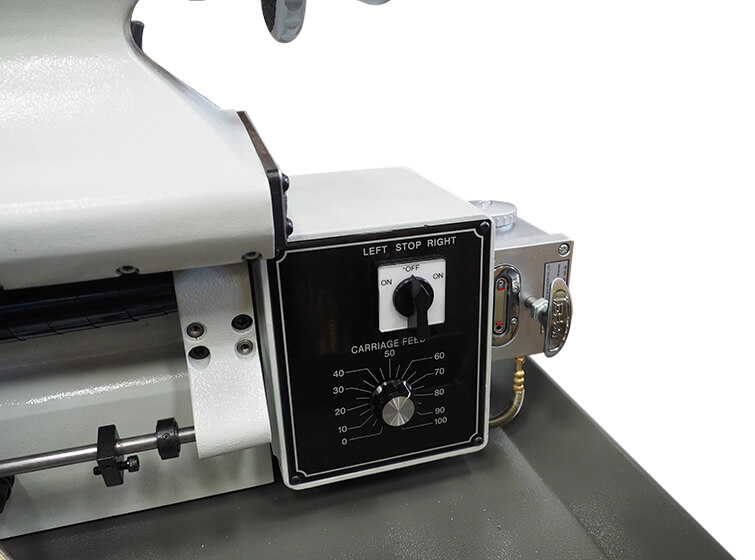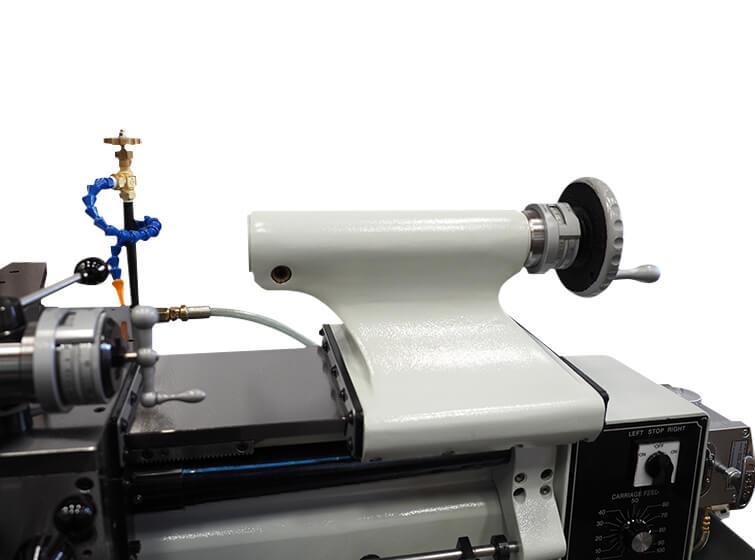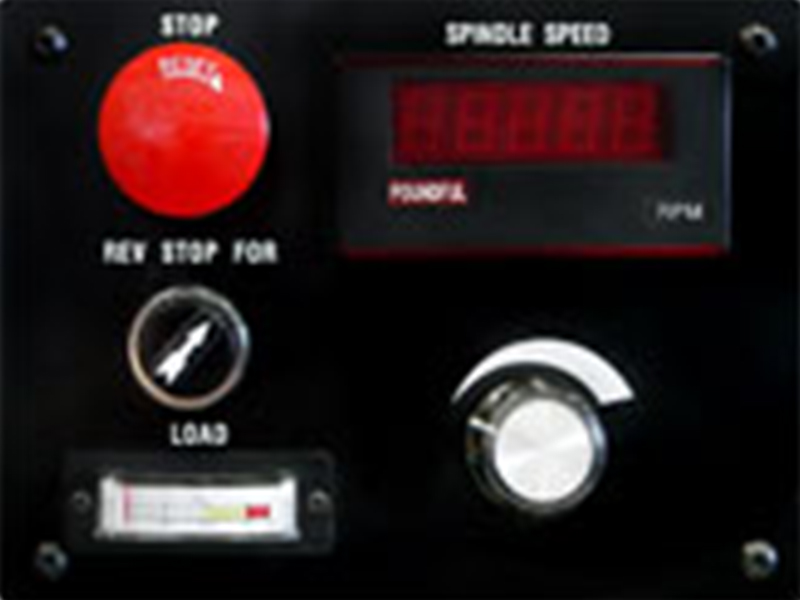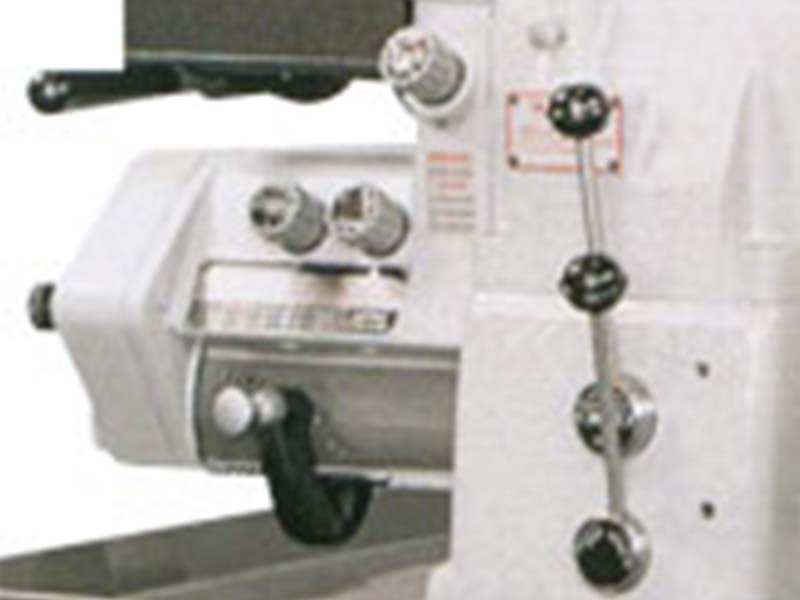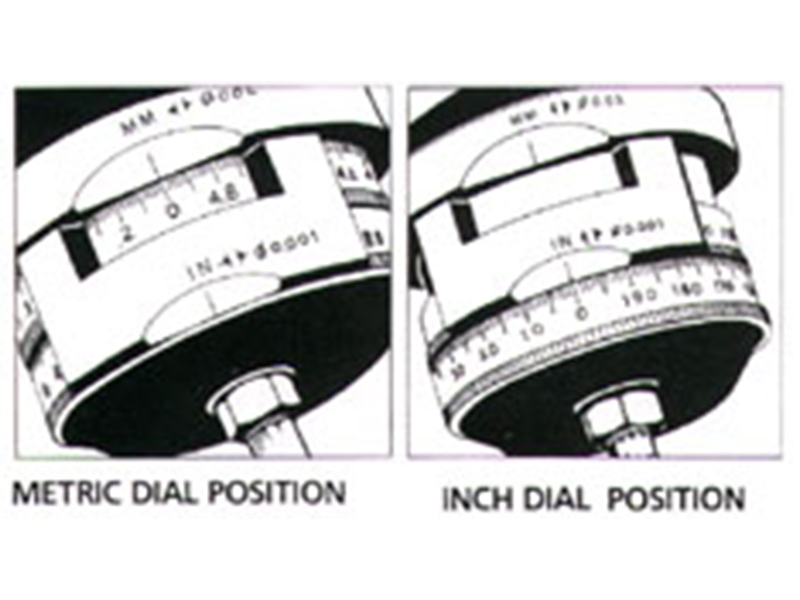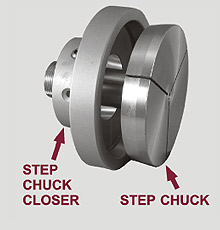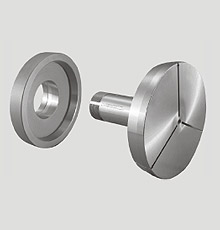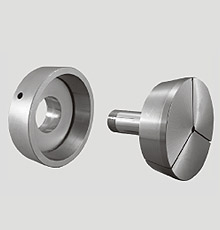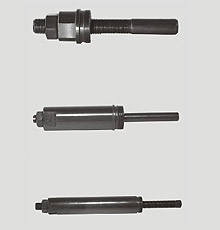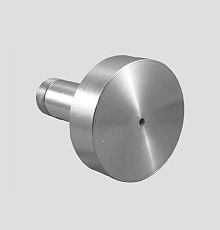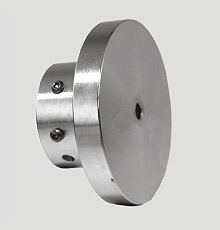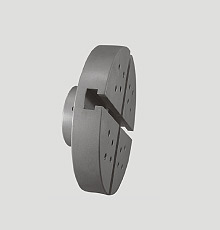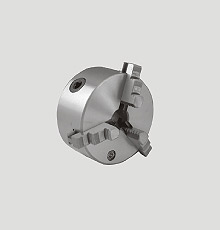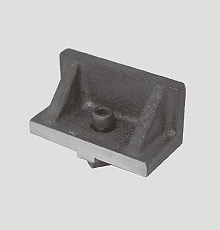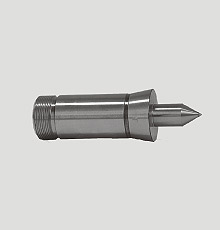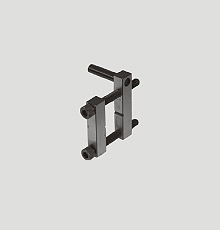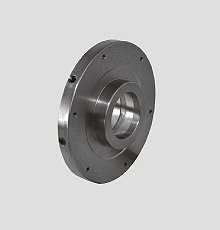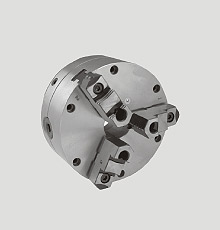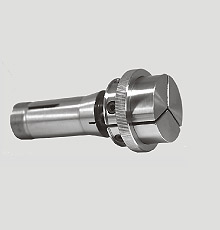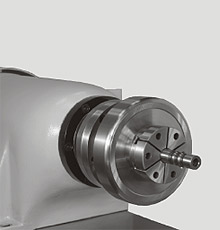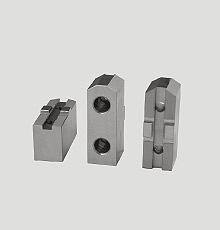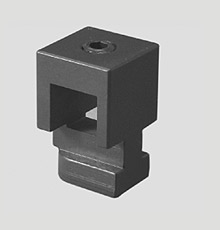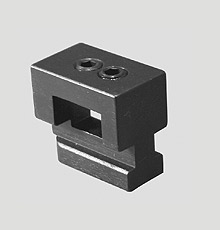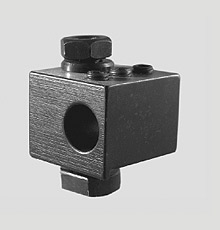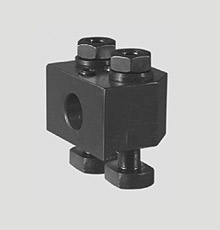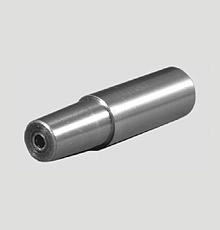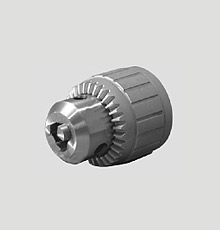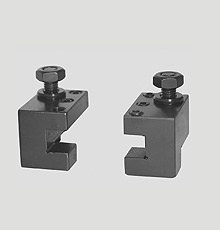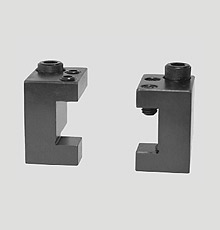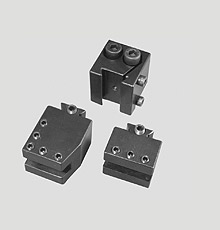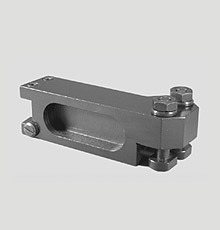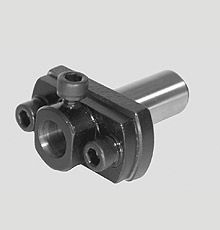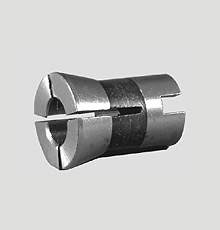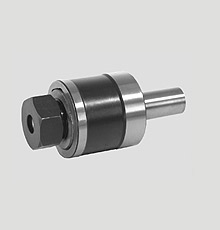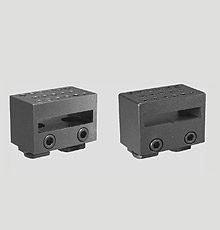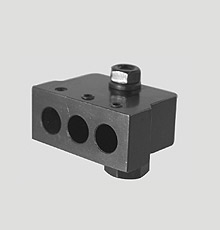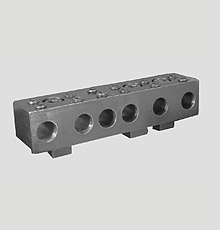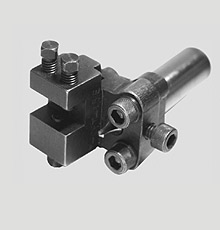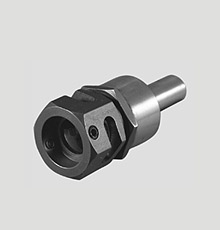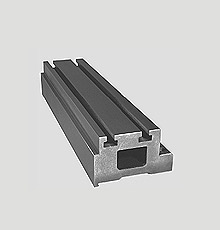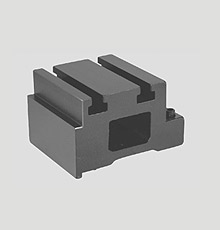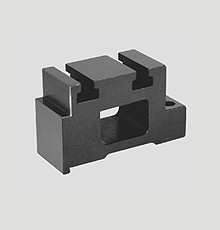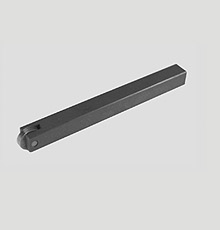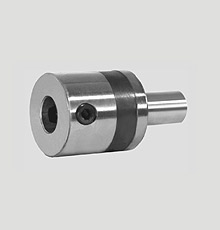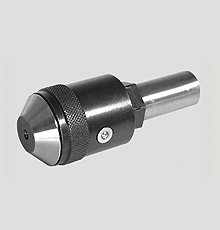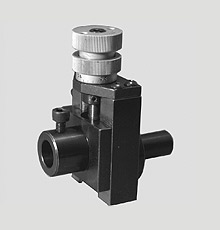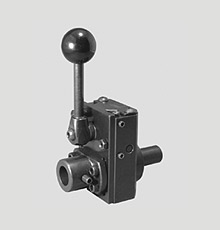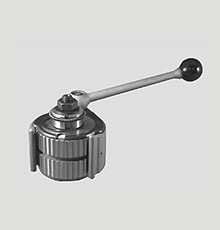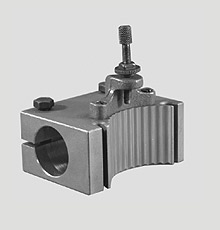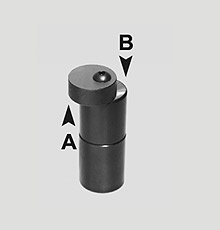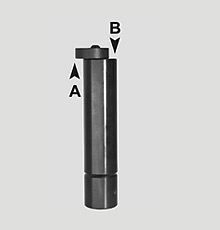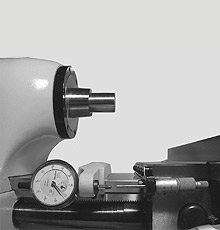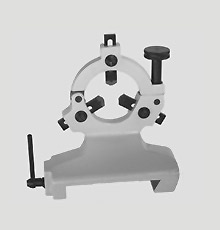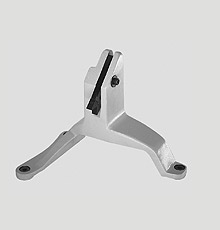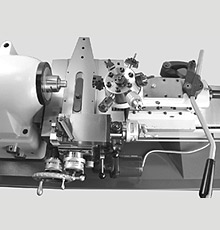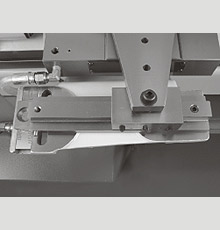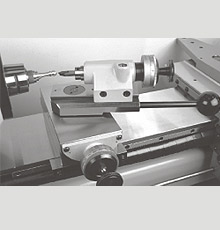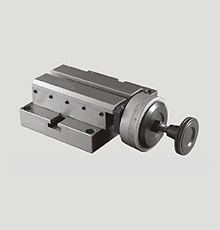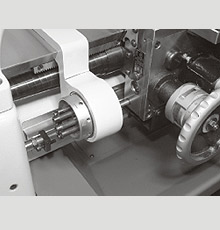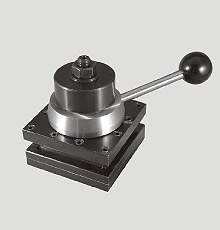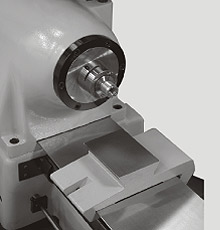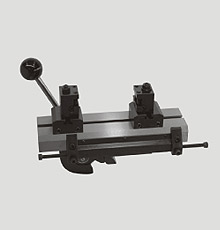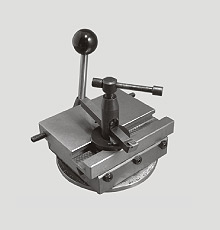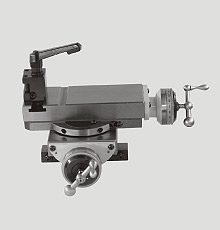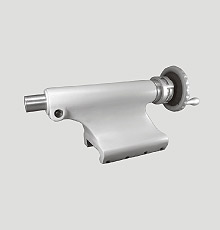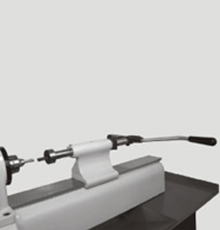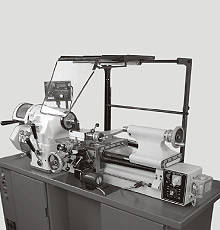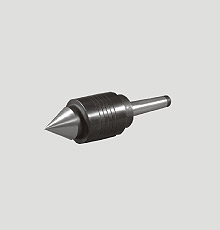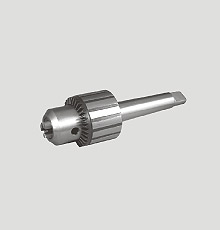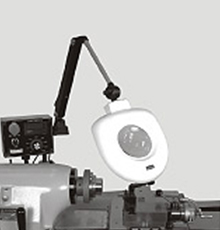- 280mm (11") Swing over bed.
- 457mm (18") Distance between centers.
- Dual range Inch/Metric quick change gearbox.
- Infinitely variable spindle speeds from 50-4000 RPM
- Full bearing carriage with Turcite-B slideway bearing material between carriage and bed.
- The spindle is mounted in high precision preloaded angular contact ball bearings eliminating radial and end play.
- Fast lever collet chucking with a single movement.
- Independent infinitely variable feeds produce accurate cuts with efficient chip removal, and smooth surface finish.
- Quick change gear box for easy precision threading.
- Automatic thread length control with fine adjustable stops provides for accurate threading without thread relief.
- Quick-action tool post slide for threading is instantly cleared from the work for a carriage return.
- The specially designed bed way is made of hardened and ground alloy, tool steel that resist wear. The angular guide ways allow chips to fall in the chip tray.
SPINDLE TOOLING, TOOLING HOLDER AND OPTIONAL EQUIPMENT FOR CYCLEMATIC HIGH SPEED. HIGH ACCURACY TOOLROOM LATHES








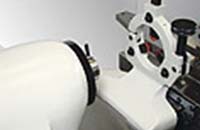

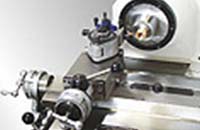
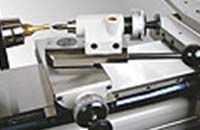
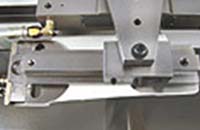

Control Panel
Electronic vari-speed system with inverter infinitely variable spindle speeds can be instantly set from 50 to 4000 RPM while the spindle is running. The actual RPM is viewed in an easy to read digital display enclosed in the speed control unit.
| MODEL | CTL-618EVS | |
|---|---|---|
| Spindle Capacity | With Chuck | 150 mm (6") |
| With Expanding Collets | 76 mm (3") | |
| With Round 5C Collets | 27 mm (1-1/16") | |
| With Hexagon 5C Collets | 22 mm (7/8") | |
| With Square 5C Collets | 19 mm (3/4") | |
| With Step Chucks | 27 ~ 152mm (1-1/16-6") | |
| Spindle Nose Diameter | Ø55.5 mm (Ø2.189") | |
| Spindle Nose I.D/O.D | 5C (10°) / 4° Taper | |
| Spindle Speeds (Variable) | 50-4,000 rpm (5C) / 50-3,000 rpm ( with 6" 3-jaw chuck) | |
| Inverter Spindle Motor | 3 HP | |
| Hole Through Spindle | 31.75mm (1-1/4") | |
| Bar Stock Diameter (5C collet) | Ø27 mm (Ø1-1/16") | |
| Distance Between Centers | 457 mm (18") | |
| Swing Over Bed | 280 mm (11") | |
| Swing Over Carriage | 230 mm (9") | |
| Swing Over Cross Slide | 152 mm (6") | |
| Carriage Power Feed Range (Variable) | 8~178 mm (5/16" ~ 7") | |
| Cross Slide Power Feed Range (Variable) | 5~102 mm (3/16" ~ 4") | |
| Cross Slide Travel | 152 mm (6") | |
| Quick-action Compound Slide Travel | 2.5 mm (0.1") | |
| Compound Slide Travel | 76 mm (3") | |
| Tailstock Spindle Diameter | Ø34.5 mm (1.358") | |
| Tailstock Spindle Taper | MT. #2 | |
| Tailstock Spindle Travel | 95 mm (3-3/4") | |
| Coolant Pump | 1/6HP, 220V, 3PH | |
| Feed Inverter Motor | 1/2 HP | |
| Range of Threads | 0.275~2.7 mm (11~108 TPI) | |
| Main Motor | 3 HP, 220V, 3PH | |
| Feed Motor | 110V, 70W | |
| Net/Gross Weight | 1,804/2,024 lb. (820/920 kg.) | |
| Machine Packing Dimension | 1,910 x 850 x 1,860 mm (75" x 33" x 73") | |
| All dimensions, specifications and machine appearance are subject to change without prior notice. | ||
CONTENTS:
- PURPOSES OF THIS MANUAL
- LEVEL ADJUSTMENT PROCESS
- LIFTING MACHINE
- INSPECTION AND CLEANING OF MACHINE
- FOUNDATION, INSTALLATION, AND LEVELING
- ELECTRICAL CONNECTIONS
- LUBRICATION
- SPINDLE CONTROL LEVERS
- QUICK CHANGE GEAR BOX
- AUTOMATIC THREAD LENGTH CONTROL
- SPINDLE BRAKE
- BELT ADJUSTMENT
- COLLET CLOSER REMOVAL
- COLLET CLOSER REPLACEMENT
- COLLET CLOSER ADJUSTMENT
- CARRIAGE INDICATING RING
- CARRIAGE LOCK
- CARRIAGE CLUTCHES
- CROSS SLIDE INDICATING RING
- QUICK-ACTING TOOL POST COMPOUND SLIDE ASSEMBLY
- POWER FEED UNIT
- COOLANT FACILITIES
- TAILSTOCK
- TAILSTOCK SPINDLE LOCK
- TAILSTOCK BODY LOCK
- THREAD CUTTING
- OUTSIDE CHANGE GEARS
- INCH THREADS USING OUTSIDE CHANGE GEAR
- METRIC THREADS USING OUTSIDE CHANGE GEARS
PURPOSES OF THIS MANUAL
The model CTL-618EVS series machine is built for easy and safe operation and excellent manufacturing of work in process. The machine is built with high quality material, and carefully to exacting standards that guarantee the life, economical use, accuracy, and minimum maintenance of the machine.
This manual is an introduction to the CYCLEMATIC model CTL-618EVS HIGH ACCURACY TOOL ROOM LATHE. It is used for installation, operation and maintenance of the CTL-618EVS CYCLEMATIC MACHINES.
Also, for fast reference, because it is necessary to make minor adjustments or do preventive maintenance. (For personnel and operators who deal with the CTL-618EVS machine.)
FOR MODEL CTL-618EVS EQUIPPED WITH ELECTRONIC VARI-SPEED SYSTEM
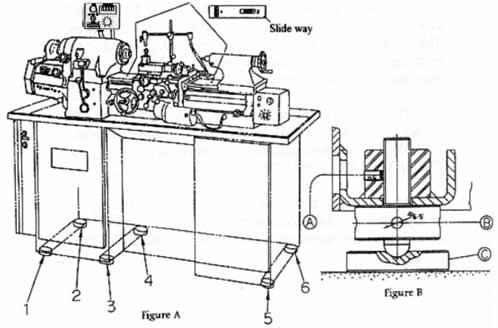
- Put pads C (Fig.B) under each of six points.
- Loose set screw A (Figure B)
- Insert a psin wrench into the hole B. Raise or lower by turning (C.W.or .C.W)
- Tighten set screw A (Fig.B) to lock.
- Be sure every point is touching the ground to support the machine.
LIFTING MACHINE
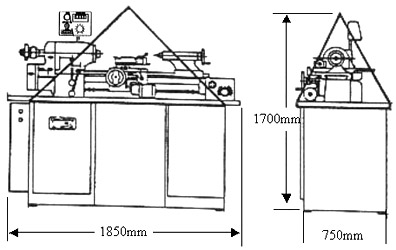
Figure 1 - Lifting machine
Lifting machine, arrange rope or cable as shown in figure 1, and check to see if the correct balance has been obtained. Then insert pads of soft cloth between the edges of the rope and machine. The net weight of this machine is approx 1050 kgs (2300 lbs). So the rope or cable must be rated at 3000 lbs capacity.
A.) INSPECTION AND CLEANING OF MACHINE
An inspection should be made after arrival of the machine in your plant. Look for possible damage caused by shock or vibration during transportation, also check for any missing parts, standard tools or other equipment.
In shipment, all exposed surfaces of the machine are coated with a antirust liquid. Before moving carriage and cross-slide, leadscrew tailstock…etc, these surfaces should be thoroughly cleaned to remove all antirust liquid use a soft brush and solvent. This is very important because it can prevent any dirt or grit which may have accumulated on the antirust liquid from working under the sliding members and causing undue wear.
※CAUTION:
DO NOT USE COMPRESSED AIR TO CLEAN, WHICH WILL REDUCE THE MACHINES LIFE.
B.) FOUNDATION, INSTALLATION, AND LEVELING
A fairly flat foundation and proper installation will provide the machine long-term high accuracy, so supplying a good solid foundation of proper thickness is important. (Generally , a thickness of 300mm (12") is considered to be enough.) The machine has six adjustable feet on the coners of the pedestal base, used for leveling the machine. Place the pads under the feet of pedestal. To adjust, loosen the set screw and raise or lower the foot with a pin wrench so that all six feet rest firmly on the floor. When the adjustment is done, tighten set screws.
C.) ELECTRICAL CONNECTIONS
The CTL-618EVS TOOLROOM LATHE is shipped completely wired and assembled, Turn Cam Switch "A" (Figure 2) to the "OFF" position, then check motor voltage. Loosen screws "B" (Figure 2), and open the switch case cover, connect the wires from the power source to the terminals (R.S.T), and ground connection is made at the "G" (Figure 3) which is the electric switch case.
Pull out Spindle locking Pin "E" (Figure 4), turn "C" (Figure 5) in forward position. The spindle should rotate counterclockwise when viewed from the tailstock end of the machine. If the spindle dose not turn in the correct direction, turn Cam Switch "A" (Figure 2) to "OFF" position. Disconnect electric power source, and interchanges any two leads until the turning direction is correct. When the spindle is rotation correctly, secure switch case cover, turn Cam Switch "A" (Figure 2) to "ON" position.
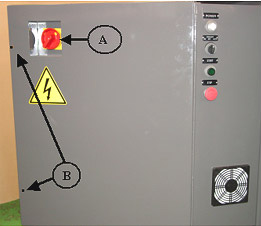
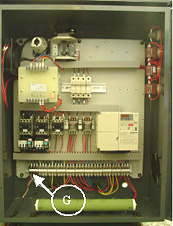


D.) LUBRICATION
Proper lubrication supplied carefully , will maintain the life and performance of the machine for a long period. Therefore, lubricate the machine with a high quality lubricant, and check periodically to assure that the lubricant in the oil sight gage is filled to the proper level.
1. CARRIAGE LUBRICATIONFill with Mobil Vactra Oil No.2 or equivalent in oil reservoir. Lift plunger on reservoir "R" (Figure 5) hold briefly and release to keep bed ways lubricated.
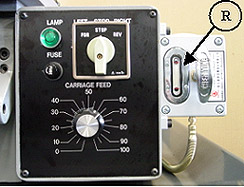
Maintain oil level in sight windows "W" (Figure 8). To fill gearbox, remove plug "C"(Figure 8) use Automatic Transmission Fluid Mobil 200 (Esso ATF or equivalent Change oil every 500 hours.)
To drain oil, remove the Drain Plug "M" located under the oil gear box (Figure 8).
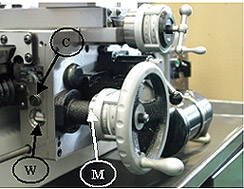
※CAUTION:
USE OF ANY OTHER TYPE OF OIL IN THE GEARBOX MAY RESULT IN DAMAGE TO THE CLUTCH SURFACES.
The headstock spindle is mounted on precision preloaded ball, bearings. The ball bearings are grease packed for life and require no further lubrication.
E.) SPINDLE BRAKE
To change spindle speeds. Push start button (D) Figure (9). Turn cam switch (C) Figure (11) to the forward or reverse position and move lever (G) Figure (10) to the start position. Turn cam switch (I) Figure (11) to the right to increase speed and to the left to decrease speed.
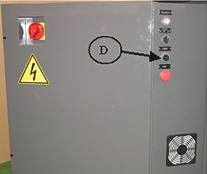
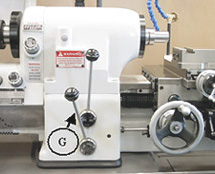

F.) QUICK CHANGE GEAR BOX
The Quick Change Gear Box Unit see (Figure 12 & 14), feed or thread change knob "T", shifted to left is threading, shifted to right is feed only. The range of threads, their selection and the position of the knobs for each thread are shown on the chart "C" (Figure 13). Pull out the ball of gear change arm "A" (Figure 13). Then move arm to left or right, insert in correct position, and change the selector knob "S" (Figure 13) to 1,2 or 3 position until desired thread cutting is acquired see (Figure 13). The standard threads and pipe threads are immediately available through the gear box by the use of outside change gears (five change gear assembly), pitches of threads can be cut to 250 threads per inch.
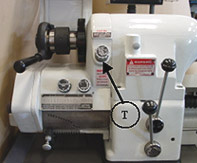
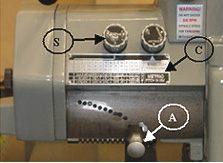
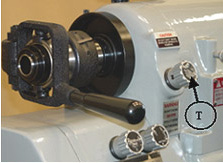
※CAUTION:
DO NOT SHIFT GEARS KNOB "T" WHEN THE SPINDLE IS RUNNING.
G.) AUTOMATIC THREAD LENGTH CONTROL
When threading into a blind hole or to a shoulder without a thread relief. The lead screw half nut if engaged at the start of the threading work is completed. Left or right hand threads are controlled by Control lever "D" (Figure 15), the lever is joined with the control bar "B" (Figure 16). When the carriage touches the adjusting screw "S" (Figure 16) of the length control bar, it will push the lever "D" (Figure 15) to "STOP" position, and make the lead screw stop. For method of threading cut, please see Page 10, QUICK ACTING.
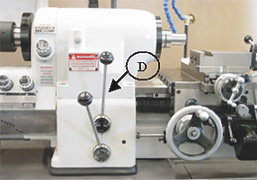
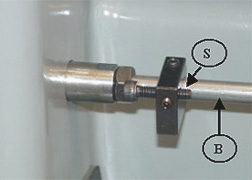
H.) SPINDLE BRAKE
Inverter unit "E" is used to perform dynamic braking. In addition, discharge resistor "C" shortens braking time (Figure 17).
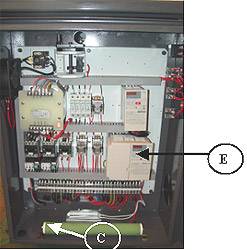
I.) SPINDLE BRAKE
Run spindle at approximately 1000 rpm. Move lever "G" (Figure 18) to center "STOP" position and let the spindle coast to a stop. This is done to equalize belt tension. Loosen lock nut "N" (Figure 19) 19mm wrench. Turn adjusting screw "P" (Figure19) 6mm socket head wrench clockwise to tighten belts. Stop machine and check belt tension, there should be approx. 25.4mm (1〃) of play in belt.
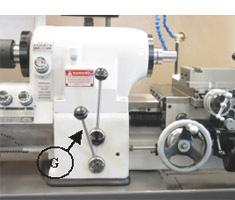
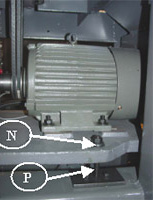
J.) COLLET CLOSER REMOVAL
Running the machine with the collet closer and not having a collet locked in place will damage the collet closer. Remove the collet closer when using chucks, face plates, or spindle nose type fixtures. The collect closer should be removed often for cleaning to prevent loading of chips between collet closer tube and inside of spindle at rear and collet threads. Removal method is : Pull out pin"L" (Figure 20). Slide draw tube out of the spindle. Do not turn the adjusting nut "N" (Figure 20). It is keyed to the spindle. To remove slide it off the end of the spindle. Do not remove collet closer by removing screw "S" (Figure 20), this screw has been adjusted at the factory for proper operation of the collet closer.
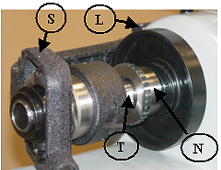
K.) COLLET CLOSER REPLACEMENT
Before replacement of the closer, clean inside of the headstock spindle and outside diameter at rear of spindle where Adjusting Nut "N" (Figure 20) is located. Apply a film of light oil on rear of spindle Do not force Adjusting Nut "N" (Figure 20) on spindle. If Adjusting Nut "N" (Figure 20) fits to tight, remove and check for burrs or scratches, then replace. Clean collet closer tube inside and out apply a film of light oil on slip surface "T" (Figure 20) of the collet closer tube, replace collet loser and insert Link Pin "L" (Figure 20).

L.) COLLET CLOSER ADJUSTMENT
- Before using collet closer, and any collet or step chuck to be used should be thoroughly cleaned.
- Push the lock Pin "E" (Figure 21). To engage lock pin, turn spindle by hand till lock pin enters notch to lock.
- Press the Closer Adjusting Finger "F" (Figure22) down to the point "P" (Figure 22).
- Guard "G" (Figure 22) forward with the left hand, and hold the collet or stop chuck with the right hand at the same time.
- Place a work piece in collet or step chuck.
- Place lever "L" (Figure 22) to the extreme left fixed position. Turn the Shell Guard "G" (Figure 22) toward operator until the work piece is clamped by the collet.
- Place lever "L" (Figure 22) to the right, the released position. Turn Shell Guard "G" (Figure 22) toward operator, move the Adjusting Finger "F" (Figure 22).
- Test collet closer's tension on work piece. If the work piece needs additional gripping pressure, press down on the adjusting finger "F" (Figure 22) and turn Shell Guard "G" (Figure 22) forward and lock. (see figure 22).
Test collet closer's tension on work piece. If the work piece needs additional gripping pressure, press down on the adjusting finger "F" (Figure 26) and turn Shell Guard "G" (Figure 26) forward and lock.

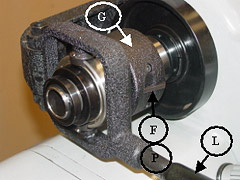
M.) CARRIAGE INDICATING RING
Dual dials with Inch and Metric Handwheel dial "W" (Figure 23) graduations are in 0.01〃 0.2mm. It is built for the operator's convenience of operation. (Figure 22) Spring loaded indicating ring, just turn to required location by loosening lock screw "L" (Figure 23) Sliding cover cage exposes only the dial in use.

N.) CARRIAGE LOCK
To hold the carriage in a fixed position on the bed use the Carriage Lock Handle "H" (Figure 24). Move the lock handle "H" (Figure 24) clockwise toward the operator, lock the carriage in position. Move the lock handle "H" (Figure 24) counterclockwise away from the operator. To unlock the carriage.
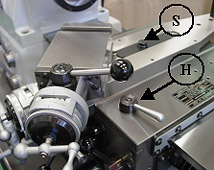
O.) CARRIAGE CLUTCHES
The carriage clutches are made of a friction type material, designed to slip when slide or carriage engages a feed stop. The clutches are a spring-loaded arrangement and can not be adjusted for more pulling power. If clutch slips under a cut, it is a sign of improper tool grinding, dull tool or excessive feed. The friction clutches have sufficient power to handle all work.
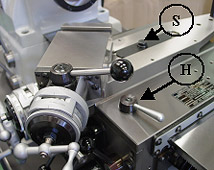
When the machine contacts a feed "stop", it is intended for the clutch to slip, To operate clutches as shown in (Figure 25), raise handle "H" (Figure 25) is approx. 20degress above horizontal, the clutch will engage, Push down the handle "H" (Figure 25), the clutch will release. When the carriage lead screw is engaged for threading the carriage feed clutch is mechanically interlocked (can not be engaged). This is to prevent machine damage. Adjust clutches as shown in Figure 25.
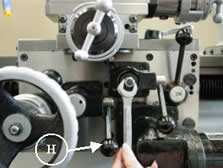
P.) CROSS SLIDE INDICATING RING
Dualdials with inch and metric handwheel dial. Each graduation of the Indicating Ring "C" (Figure 26) is 0.02mm (0.001") on the diameter. It is provided for operator's convenience. The Indicating Ring is spring loaded, so a lock screw is not needed. To use it, just turn the Indicating Ring to required location by hand. Cross Slide operation of freed and adjustment of clutches are identical with the operation and adjustment of carriage clutches. If CTL-618EVS TOOLROOM LATHE needs to be used with the taper turning attachment, loosen the screw "S" (Figure 26) with a spanner wrench.
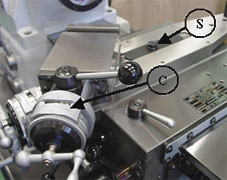
Q.) QUICK-ACTING TOOL POST COMPOUND SLIDE ASSEMBLY
The compound slide has a quick-acting tool post, at the start of threading cut, place the ball-handle "H" (Figure 21) of the quick-acting tool post toward the workpiece, at the end of the threading cut, the threading tool is instantly cleared from the work by hand operated, handle "H", for the return of the carriage to the next cut, the ball-handle lever actuating the tool post slide feed screw. Operate above procedure repeatedly until the threaded work piece is completed. Each graduation of the indicated ring "C" (Figure 21) is 0.001" (0.02mm) on diameter.
※ CAUTION:
THE BALL-HANDLE LEVER OF THE QUICK-ACTING TOOL POST MUST BE MOVED TOWARD OPERATOR AT THE END OF THE THREADING CUT.
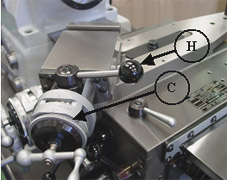
Ring and Quick Acting
R.) POWER FEED UNIT
The carriage Power Feed unit is mounted on the carriage.
It is powered by a AC motor "M" (Figure 28).
- The power feed can be operated only when the machine is running. Start the power feed by turning Cam Switch "S" (Figure 29).
- The Cam Switch "S" (Figure 29) controls the direction of the power feed.
- The carriage Feed Control "N" (Figure 29) controls the rate of feed. When Cam Switch "S" (Figure 29) is placed in "RIGHT" position, the carriage will feed toward the right, the cross slide will feed away from the operator.
- When Cam Switch "S" (Figure 29) is placed in "LEFT" position, the carriage will feed toward the left, the cross slide will feed toward operator.
- Turn Cam Switch "S" (Figure 29) to "STOP" position, power feed motor is turned off.
- The rate of the carriage feed should be pre-selected to suit each particular job, which depend on material, diameter, type of cut, and tooling used.
- The numbers on the carriage feed control panel, do not represent either thousandths per revolution or inches per minute. So the operator must test sample pieces for determining the spindle speed and rate of feed which can best suit to the requested surface finish and production rate, then record the proper settings after testing.
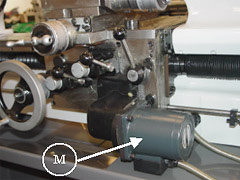

NOTE:
WHEN STARTING INTO PRODUCTION. AN OPERATOR CAN SET THE FEED CONTROL "N" TO THE RECORDED REFERENCE SETTING, THEN THE SAME TESTED RESULTS WILL BE OBTAINED.
S.) COOLANT FACILITIES
The coolant pump is controlled by Switch "C" (Figure 30). Turn Switch "C" (Figure 30) to "ON" position, the pump will run continuously, turn to "AUTO" position, the pump will run only when the machine is running. If pump switch is set at "OFF" position, the coolant pump is off. Sump should be cleaned periodically, depending on the type of material being machined.
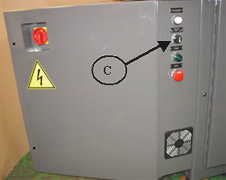
T.) TAILSTOCK
The tailstock is mounted on preloaded ball bearings and can support any load to the spindle. It is provided with a fine "feed" for accurate work. The spindle of the tailstock is graduated in eighths of an inch, and 1mm and has a travel of 95mm (3-3/4〃) The handwheel is dual dial Inch and Metric. Graduations are 0.02mm (0.001〃). It is built for the operator's convenience of operation just turn the dial ring "D" (Figure 32) to the required location. It is unnecessary to tighten the dial rings. They are spring loaded, so a lock screw is not needed. Sliding cover cage exposes only the dial in use.
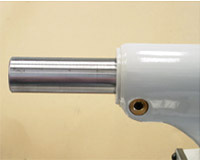

U.) TAILSTOCK SPINDLE LOCK
The tailstock spindle lock holds the spindle securely in any travel position. Move lever "L" (Figure 33 toward the headstock lock position and backward to the released position.
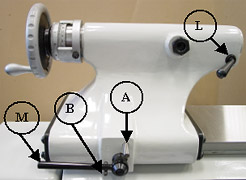
Tailstock Spindle and Body Lock
V.) TAILSTOCK BODY LOCK
The tailstock can be clamped in any position along the bed way by operating Lever "M" (Figure 33). The Lever "M" (Figure 33) should be adjusted to a clamp position between the two stop pins "A" (Figure 33) and "B" (Figure 33). When tailstock is fully clamped, lever "M" (Figure 33) should not contact stop pin "A" (Figure 33).
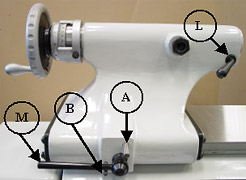
Tailstock Spindle and Body Lock
THREAD CUTTING
CAUTION : DO NOT RUN SPINDLE IN REVERSE WHEN THREADING.The CYCLEMATIC CTL-618EVS is designed for rapid and accurate thread cutting. The quick-change gearbox permits instant selection of 36 different inch and metric threads. Threads can be cut to a shoulder without running into the shoulder since the automatic stop will limit carriage travel at a predetermined point in either direction. Before staring to cut a thread, select the proper cutting speed for the size of thread to be cut and to give the best finish for the particular material being used. Maximum recommended threading speed is 800R.P.M.
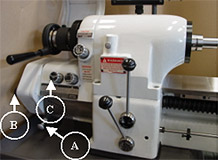
Set the quick-change gearbox for desired pitch. To make a selection on the gearbox thread chart, pull the spring-pressured knob "A" (Figure 34), out as far as it will go and lower it until it will move sideways to the desired notch directly under the thread required. Raise the handle and let plunger drop into hole. If tumbler handle will not raise far enough to position plunger into hole, loosen knob "S" (Figure 35), open gear box door and rotate gear "T" (Figure 35), until gears mesh and handle raises, permitting plunger to seat.

Set selector knob "C" (Figure 34), for number corresponding to left side of gearbox thread chart. Set knob "C" (Figure 34) so desired number is in bottom position in line with arrow. If the sliding gear cluster dose not engage the other gears in gearbox properly to bring the desired number on selector knob "C" (Figure 34) in line with arrow, loosen knob "B" (Figure 34) open gearbox door and rotate gear "T" (Figure 35), until gear mesh.
Set Inch/Metric knob "D" (Figure 36), so thread system to be cut reads at top of knob, If the sliding gear does not engage properly to bring desired system to read at top, loosen knob "B" (Figure 36), OPEN GEARBOX DOOR AND ROATE GEAR "T" (Figure 37), until gears mesh and knob is felt to engage detent.
Engage gearbox by turning knob "E" (Figure 36), counterclockwise in the direction of arrow marked "THREAD" When turning knob "E" (Figure 36) <THE TEETH OF THE SLIDING GEAR WITHIN THE GEARBOX.> May not mesh with the headstock spindle gear teeth. If this is the case, turn headstock spindle with handwheel "F" (Figure 36) while turning knob "E" (Figure 36) to left until definite click is heard.
Set compound slide at 61° and position cutting tool in compound slide tool post. Position carriage with handwheel so threading tool is in the center of the part to be threaded.
Carriage control lever "G" (Figure 36), when moved to the left, will cause carriage to move to the left. When the carriage control level is moved to the right, the carriage will move to the right. Carriage travel can be stopped at any time by placing control lever "G" (Figure 36) in center position.
NOTE : Carriage power feed unit is not used during threading operation.The tailstock is mounted on preloaded ball bearings and can support any load to the spindle. It is provided with a fine "feed" for accurate work. The spindle of the tailstock is graduated in eighths of an inch, and 1 mm and has a travel of 95mm (3-3/4") The hand wheel is dual dial Inch and Metric. Graduations are 0.02mm (0.001"). It is built for the operator's convenience of operation just turn the dial ring "D" (Figure 35) to the required location. It is unnecessary to tighten the dial rings. They are spring loaded, so a lock screw is not needed. Sliding cover cage exposes only the dial in use.
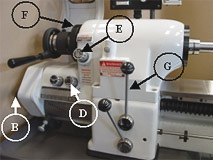
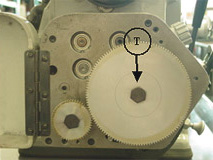
Place lever "G" (Figure 38) in center position and engage lead screw nut "J" (Figure 40), by moving ball handled lever "H" (Figure 40) clockwise. Set two carriage stops "M" (Figure 39) approximately 1/2〃 from both ends of carriage. Loosen screw "K" (Figure 39) to make area location of stops. Loosen lock screw "N" (Figure 39) and turn stop screw "L" (Figure 39) to make fine adjustment. With threading tool away from work toward operator, make a trial run with the carriage. Pick up the exact relation between the tool and the shoulder or end of the thread by using the tool post slide. Run carriage to the right, checking the stop. Make adjustments so tool will clear end of work by 1/4".
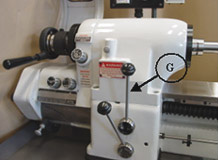
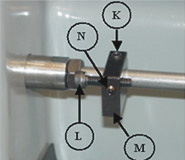
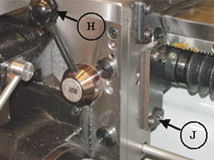
CAUTION : Lock carriage stops securely before starting to cut the threads. Do not release carriage nut "J" until threading operation is completed.
With carriage at rest and quick-acting handle "P" (Figure 42), forward in cutting position, feed the desired amount for each threading pass using cross slide handwheel "R" (Figure 42).
Moe lever "G" (Figure 41), to the left and carriage will travel until it contacts stop at headstock end of machine. The headstock spindle will continue to run. Carriage stops cause only the gearbox, lead screw and carriage to stop.
After each pass, withdraw threading tool from work with quick-acting handle "P" (Figure 42), and return carriage to starting position by moving carriage control lever "G" (Figure 41), to the right.
LEFT-HAND THREADS can be cut the same as right-hand with the spindle running "FORWARD" except that cutting pass is made from the headstock toward the tailstock. Carriage control stops are used for left-hand threads as well as right-hand threads.
The tailstock is mounted on preloaded ball bearings and can support any load to the spindle. It is provided with a fine "feed" for accurate work. The spindle of the tailstock is graduated in eighths of an inch, and 1 mm and has a travel of 95mm (3-3/4") The hand wheel is dual dial Inch and Metric. Graduations are 0.02mm (0.001"). It is built for the operator's convenience of operation just turn the dial ring "D" (Figure 35) to the required location. It is unnecessary to tighten the dial rings. They are spring loaded, so a lock screw is not needed. Sliding cover cage exposes only the dial in use.
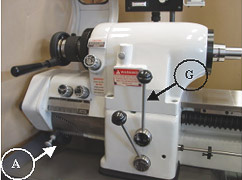
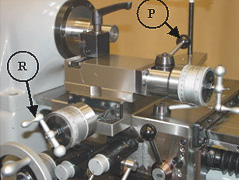
OUTSIDE CHANGE GEARS
The outside change gears are used to cut threads not provided in the quick-change gearbox. A set of five gears and a bracket are supplied as standard equipment with each machine. These gears, when set up to the gear chart, Figure 45 will cut 10 threads per inch or 0.25mm pitch according to set up. Three of the gears are shipped on the bracket and the other two are in place on the shafts as shown at "U" (Figure 44) and "W" (Figure 44).
BEFORE SETTING UP CHANGE GEARS, PLACE KNOB "A" (FIGURE 43), IN THE "OUT" POSITION.Fastened to the tumbler handle bracket within the gear box is round safety bar "X" (Figure 44), that extends out through a slot in the gearbox plate. This bar is to prevent applying change gears outside the gearbox until the tumbler handle is placed in the "OUT" position.
Additional gears are available to cut other threads which are not available through gearbox.
Lubricate bushings and shafts on change gear bracket with spindle oil each time a setup is made. If long run threading is involved, lubricate daily.

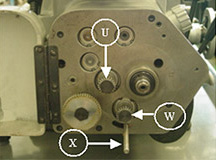
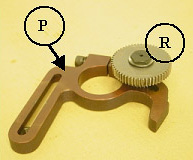
OUTSIDE CHANGE GEARS
- Turn disconnect switch "OFF".
- On inch side of change gear bracket "D" (Figure 50), mount "First Gear on Stud" "C" (Figure 50) with spacer between gears. Do not tighten bolt "A" (Figure 50) fully.
- Mount "Idler Gear" "Y" (Figure 50) but do not mesh with "First Gear on Stud" "C" (Figure 50), or tighten bolt "Z" (Figure 50) fully.
- Loosen knob "S"(Figure 48), open gearbox door and remove 50 tooth gear "S" (Figure 48), and 127 tooth gear "T" (Figure 48). Do not misplace key under 50 tooth gear.
- If thread chart specifies number of teeth in "First Gear" to be other than 22 teeth, remove gear "U" (Figure 49), and replace with specified gear.
- Remove tumbler gear "W" (Figure 49).
- Mount Change gear bracket assembly, Figure 48, on pivot post "V" (Figure 49). Do not tighten bracket bolt "H" (Figure 51), fully.
- Make certain key is in place and mount "Screw Gear" "J" (Figure 51). Replace bolts "K" (Figure 51) and "M" (Figure 51).
- Adjust "Second Gear on Stud" "G""G" (Figure 51), with 0.08〃-0.010〃 backlash between it and "Screw Gear" "J" (Figure 51). Use plastic shim stock to help determine backlash. Tighten bolt "F" (Figure 51).
- Adjust "Idler Gear" "E""E" (Figure 51) with 0.003〃-0.004〃 backlash between it and "First Gear on Stud" (behind "Second Gear on Stud" in picture). Tighten bolt "N" (Figure 51).
- Pivot bracket to obtain 0.003〃-0.004〃 backlash between "First Gear" "L" (Figure 51) and "Idler Gear" "E" (Figure 51). tighter bracket bolt "H" (Figure 51).
- Make certain all gears are properly meshed and all bolts tightened.
- Close gearbox door, tighten knob "B" (Figure 46), and turn selector knob "C" (Figure 46) to position specified on chart.
- Turn Inch/Metric knob "D" (Figure 46) to Inch.
- Turn Feed/Thread knob "E" (Figure 46) to "Thread"
- Follow same procedures for setting carriage stops lead screw nut and compound slide as when cutting threads form the gearbox. Use of carriage control level "G" (Figure 46), and quick-acting handle "P" (Figure 47), will also be the same as when cutting threads from the gearbox.
NOTE :
(a) 50 tooth gear "S", (Figure 48), and 127 tooth gear "T"(Figure 48) must be remounted (without bracket) to obtain metric thread pitches through gearbox.
(b) When disassembling setup, remount 22 tooth gears "U"(Figure 49) and "W"(Figure 49), Figure 5.
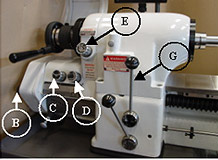
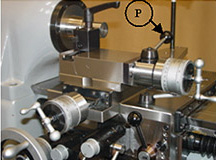
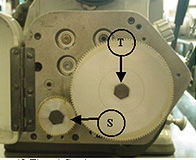
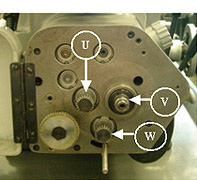

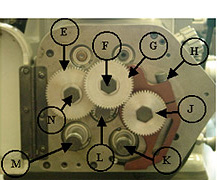
METRIC THREADS USING OUTSIDE CHANGE GEARS
- Turn disconnect switch "OFF".
- On metric side of change gear bracket "P" (Figure 56) mount "Idler Gear" "R" (Figure 56). Do not tighten bolt "S" fully.
- Loosen knob "B" (Figure 52), open gearbox door and remove 127 tooth gear "T" (Figure 54).
- Mount change gear bracket assembly, Figure 56, on pivot post "V" (Figure 57), Do not tighten bracket bolt "U" (Figure 55) fully.
- Remove "First Gear" "U" (Figure 55), and replace bolt. Do not misplace key.
- Mount "First Gear on Screw" "T" (Figure 57).
- If thread chart specifies number of teeth in "Tumbler Gear" to be other than 22 teeth, remove gear "Y" (Figure 57) and replace with specified gear.
- Adjust "Idler Gear" "X" (Figure 57) with 0.003〃-0.004〃 backlash between it and "First Gear on Screw" "T" (Figure 57). Use plastic shim stock to help determine backlash. Tighten bolt "W" (Figure 57).
- Pivot bracket to obtain 0.003〃-0.004〃 backlash between "Idler gear" "X" (Figure 57) and "Tumbler Gear" "Y" (Figure 57). Tighten bracket bolt "J" (Figure 57).
- Make certain key is in place and remount 127 tooth gear "A" (Figure 58). Tighten bolt "Z" (Figure 58).
- Make certain all gears are properly meshed and all bolts tightened.
- Close gearbox door, tighten knob "B" (Figure 52), and turn selector knob "C" (Figure 52) to position specified on chart.
- Turn Inch/Metric knob "D" (Figure 52) to "Metric".
- Turn Feed/Thread knob "E" (Figure 52) to "Thread".
- Follow same procedures for setting carriage stop, lead screw nut and compound slide as when cutting threads from the gearbox. Use of carriage control lever "G" (Figure 52), and quick-acting handle "P" (Figure 53), will also be the same as when cutting threads from the gearbox.
- Observe same operational cautions as when cutting threads from gearbox
NOTE :
(a) 50 tooth gear "S", Figure 4, and 127 tooth gear "T" must be remounted without bracket to obtain metric thread pitches through gearbox.
(b) When disassembling setup, remount 22 tooth "Tumbler Gear" "W" Figure 5, and 22 tooth "First Gear" "U".
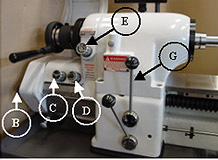
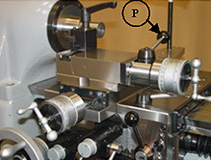
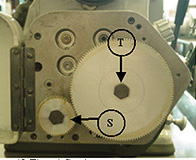
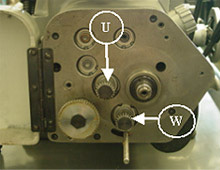

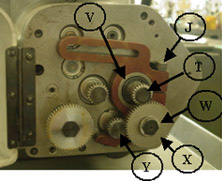
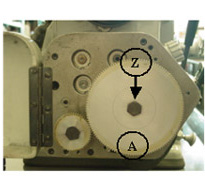
| ITEM | Part no. |
|---|---|
| 1-2 | T-CT-02 |
| 1-2 | T-CT-03 |
| 1-2 | T-CT-04 |
| 1-2 | T-CT-05 |
| 1-2 | T-CT-06 |
| 1-2 | T-202-2B |
| 1-2 | T-202-3B |
| 1-2 | T-202-4B |
| 1-2 | T-202-5B |
| 1-2 | T-202-6B |
| 1-3 | T-DCT-02 |
| 1-3 | T-DCT-03 |
| 1-3 | T-DCT-04 |
| 1-3 | T-DCT-05 |
| 1-3 | T-DCT-06 |
| 1-3 | T-203-2B |
| 1-3 | T-203-3B |
| 1-3 | T-203-4B |
| 1-3 | T-203-5B |
| 1-3 | T-203-6B |
| 2-1 | T-SS-1 |
| 2-1 | T-ES-1 |
| 2-1 | T-LS-1 |
| 2-2 | T-UCS-25 |
| ITEM | Part no. |
|---|---|
| 3-1 | T-CT-01 |
| 3-2 | T-304A |
| 3-2 | T-304B |
| 3-3 | T-FP-3B |
| 3-3 | T-FP-5B |
| 3-3 | T-FP-8B |
| 3-4 | T-FP-07B |
| 4-1 | T-317 |
| 4-1-1 | CHUCK |
| 4-1-1 | CHUCK |
| 4-1-1 | CHUCK |
| 4-1-1 | CHUCK |
| 4-2 | T-AP-07 |
| 4-3 | LT-01-109 |
| 4-4 | LT-01-108C |
| 5-1 | LT-01-110T |
| 5-2 | T-315 |
| 5-2-1 | KM-6 |
| 5-3 | S-5C |
| 5-7 | T-3SJ |
| 7-5 | TDC-6.5 |
| 7-5 | TDC-10EL |
| 7-5 | TDC-13EL |
| 7-5 | TDC-16H |
| ITEM | Part no. |
|---|---|
| 12-3 | T-KH-48 |
| 14-1 | 540-110 |
| 14-2 | 540-111 |
| 14-3 | 540-130 |
| 14-4 | C20-ER20 |
| 15-2 | TR-303 |
| 15-3 | T-CLD-618 |
| 16-2 | T-CSD-618 |
| 16-3 | T-SR-300 |
| 16-4 | T-FR-300 |
| 17-1 | T-LT-01 |
| 17-2 | T-RT-108 |
| 17-3 | T-RTS-10 |
| 18-2 | T-BLD-68 |
| 18-3 | T-AIT-06 |
| 21-1 | LB-68-1 |
| 22-1 | T-CS-10 |
| 22-2 | T-MC-2 |
| 22-3 | T-LC-2 |
| 22-4 | T-DC13-MT2 |
| 22-4 | T-DC16-MT2 |
| 22-4 | T-DC19-MT2 |
| 22-5 | HQ32122-5 |
| 1-27MM |
SPINDLE TOOLING, TOOLING HOLDER AND OPTIONAL EQUIPMENT FOR CYCLEMATIC HIGH SPEED. HIGH ACCURACY TOOLROOM LATHES














Control Panel
Electronic vari-speed system with inverter infinitely variable spindle speeds can be instantly set from 50 to 4000 RPM while the spindle is running. The actual RPM is viewed in an easy to read digital display enclosed in the speed control unit.


